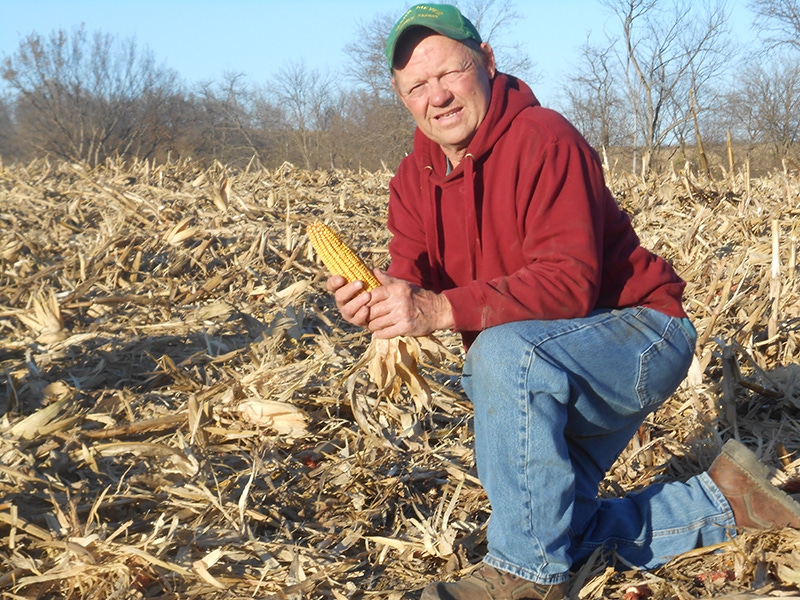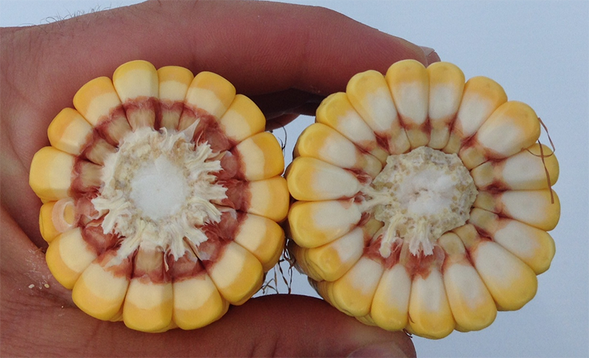January 23, 2015

U.S. corn growers planted about 11.5 million acres of drought-tolerant corn hybrids in 2014, according to seed companies offering water-optimizing traits.
Monsanto’s new Genuity DroughtGard hybrids joined Syngenta Agrisure Artesian and DuPont Pioneer Optimum AQUAmax in the expanding technology toolbox designed to minimize the effects of drought and capitalize on available water for higher yields.
Monsanto Genuity DroughtGard
“Corn growers planted about 500,000 acres of hybrids with the new Monsanto Genuity DroughtGard trait in 2014,” says Tom Eickhoff, agronomic systems lead for Monsanto. “DroughtGard was available on DeKalb, Channel and other Monsanto seed brands as well as from seed companies to whom we licensed the technology.”
Mark Meyer of Nehawka, Neb., planted 70 acres of DeKalb Genuity DroughtGard hybrids on a creek bottom that usually receives less rainfall than his other fields.
“I decided to try the hybrids because they were forecasting another dry year, and the long-term test plot data were there to back up the decision,” Meyer says.
He planted DeKalb Genuity DroughtGard DKC63-55 RIB and DeKalb Genuity DroughtGard DKC 65-81RIB at 30,000–32,000 seeds/acre in 30-inch rows.
This plant comparison shows how a DeKalb DroughtGard hybrid survived the 2012 southeast Nebraska severe drought, compared to a DeKalb hybrid without the trait.
“Southeastern Nebraska averages about 32 inches of precipitation per year,” says John McNamara, agronomist for ag input retailer Wiles Brothers Fertilizer in Plattsmouth, Neb. “We typically get between 20–22 inches during the growing season, which is about break-even for what corn needs. But in 2014, we had very little snow and only about 17 inches of total precipitation by August 21.”
“Although 2014 was generally dry, we were lucky to get rain at tasseling,” Meyer says.
Meyer’s drought-tolerant corn yielded 191.7 bushels per acre, while his non-DroughtGard hybrids averaged about 210 bushels per acre.
“I’m disappointed in the yield compared to my non-DroughtGard hybrids,” Meyer says. “But I’m not going to write off drought-tolerant corn. I generally like to see at least a three-year average of yields before I make a definite decision.”
This ear comparison shows how a DeKalb DroughtGard hybrid survived the 2012 southeast Nebraska severe drought, compared to a DeKalb hybrid without the trait.
In Wiles Brothers test plots on 17 farms spread across eight Nebraska counties, DeKalb DroughtGard DKC60-55 yielded an average of 208.9 bushels per acre; DKC63-55, 223.1 bushels per acre; and DKC65-81, 216.5 bushels per acre. The overall yield average for the 17 hybrids tested was 219.5 bushels per acre.
“The DroughtGard hybrids yielded competitively with the non-DroughtGard hybrids in the trials,” McNamara says. “They are designed not only to perform when soil moisture is at a premium but also when growing conditions are optimal.”
Channel Seeds DroughtGard
Justin Koehler of McLean, Neb., planted Channel Seeds DroughtGard hybrids on 25% of his corn acres in 2014.
Koehler raises about 2,000 acres of dryland crops on rolling hills with variable soils in northeast Nebraska. Because most of the corn is used in the family’s livestock operation and does not leave the farm, Koehler was among the first growers to try DroughtGard.
“We’ve planted DroughtGard hybrids since the bad drought year of 2012,” Koehler says. “They did well under the extreme stress. This year, we had plenty of rain and they performed really well again.”
Koehler planted Channel DroughtGard 211-00, 214-00 and 209-00 at about 24,000 seeds per acre. “They all were at least 5-10 bushels per acre more than our conventional corn,” Koehler says.
Admitting that seed corn pricing is very complex, Koehler estimates that the DroughtGard trait costs about $10 per acre. “Considering that the DroughtGard hybrids consistently yield 10-15 bushels better, the trait more than pays for itself in yield.”
Koehler plans to double the number of acres he plants to DroughtGard hybrids in 2015, going from 25% in 2014 to 50% next season.
Dupont Pioneer Optimum AQUAmax
Joe Keaschall, director of research for Dupont Pioneer, says Pioneer Optimum AQUAmax hybrids were planted on about 10 million acres in 2014, up from about 7 million in 2013.
Chad Buhl of Lindsay, Neb., has planted Optimum AQUAmax corn hybrids since they were introduced four years ago. “Living in Nebraska, we don’t always get perfect rainfall,” Buhl says. ��“Anything that will yield a few more bushels is helpful.”
Buhl farms 1,500 acres in a 50/50 corn/soybean rotation, irrigating about 70% of his rolling hills.
“I like how the AQUAmax hybrids perform,” Buhl says. “During the extreme drought in 2012, when a lot of the corn only yielded up to 40 bushels per acre, the AQUAmax hybrids yielded from 55-70 bushels per acre.”

A Pioneer Optimum AQUAmax hybrid (right) and a competitive hybrid were grown in a water-limited field in 2013. The AQUAmax corn did not demonstrate the significant leaf rolling seen in the competitor. According to Pioneer, AQUAmax hybrids use water more slowly, saving some of the moisture in the soil for use later in development. Photo: Pioneer
In 2014, his Pioneer AQUAmax P1498 and P1151 hybrids, planted at 27,000 plants per acre in 30-inch rows, yielded 228 bushels per acre on dry land and about 236 bushels per acre under irrigation. His conventional dryland corn yielded about 210 bushels per acre, with about 229 bushels per acre under irrigation.
Although Buhl has not tried to reduce the irrigation applied to his drought-tolerant corn, he says, “I always make sure to plant the hybrids in an area where I only have one pivot for two fields and may not always get back before the conventional corn starts to stress.”
Syngenta Agrisure Artesian
Farmers planted about 1 million acres of Agrisure Artesian hybrids in 2014, says Duane Martin, Syngenta marketing manager for Agrisure Artesian.
Mike Missman of Woden, Iowa, has planted Golden Harvest hybrid G01P52 Artesian brand for two years after first seeing it in test plots in 2012. Missman farms about 1,350 acres of corn and soybeans in north central Iowa on a combination of flat, heavy black soils and rolling hills with lighter, more variable soils.
“In the bad drought year of 2012, the Artesian hybrid was 20 bushels better,” Missman says. “In 2013 and 2014, we received adequate rain and it was still 10-20 bushels better.

The Syngenta Agrisure Artesian ear on the right (compared to competitor ear on left, from Slater, MO in 2014) exhibits the robust kernel fill that results from the synchronization of pollen shed and silking during pollination, a hallmark characteristic of drought-tolerant hybrids. Photo: Syngenta
“When it doesn’t rain, Artesian hybrids conserve water and yield normally, “ Missman says. “When it does rain, Artesian hybrids will match or exceed the yields of comparable hybrids.”
Missman has observed that the Artesian hybrids “have more late-season stay-green, which results in better standability, higher test weights and better grain quality. The trait allows farmers to plant top hybrids in more variable soils and harvest greater and more consistent yields from more acres.”
“Agrisure Artesian genetics were available in about 30 hybrids from Syngenta in 2014,” says Syngenta’s Martin. “Demand was remarkably even across the entire Corn Belt. Corn growers could see the benefit of water optimization virtually everywhere, not just in the western Corn Belt.”
Not just a western problem
“Periodic drought is a factor for the whole Corn Belt, from Ohio to Colorado, not just the more arid western regions,” says Tom Hoegemeyer, professor of practice at the University of Nebraska-Lincoln Institute of Agriculture and Natural Resources.
“On many soils in many years, farmers would be well served to think of planting at least a part of their acres to drought-tolerant hybrids,” Hoegemeyer says. “The lower the water-holding capacity of your soil, the higher your vulnerability to heat and drought stress, so the greater you would benefit from planting water-optimizing seed corn.”
About the Author(s)
You May Also Like




